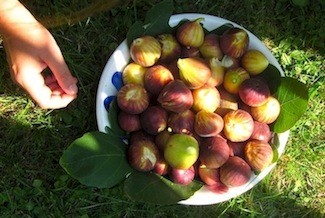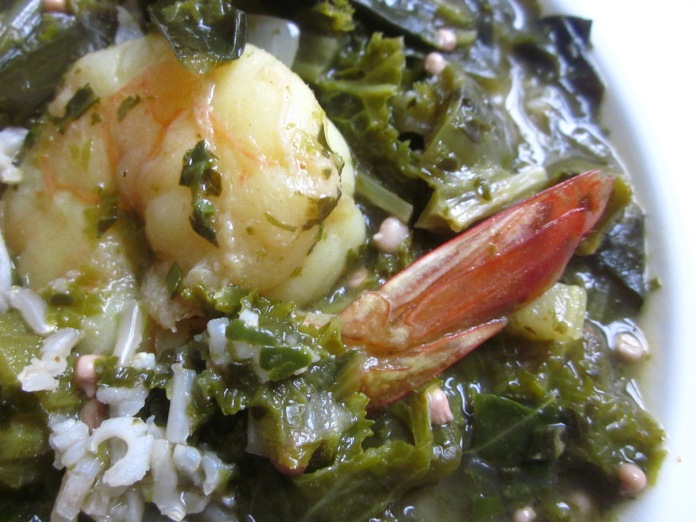With gumbo, you do watcha wanna; trying to pin down an exact recipe is like searching for gators in bayou swamp water. The mention of gumbo might conjure up thoughts of shrimp, chicken, and andouille sausage, but the beauty of the catch-all stew is that there are infinite ways to make it your own based on your mood or whatever is fresh or on hand that day. Creole seafood gumbos often include crab or oysters, while versions from Cajun country make use of venison, squirrel, and alligator. And then there’s gumbo z’herbes, a venerable sub-category of its own within the gumbo family.
Like the majority of gumbos, gumbo z’herbes uses the “holy trinity” (onion, bell pepper, and celery) as its foundation and Cajun seasoning as its primary spice. However, as its name – a shortened form of gumbo des herbes – suggests, its main ingredient is a hodgepodge of greens. According to Louisiana lore, every green you add to the gumbo signifies a new friend you’ll make that year. This past week, I used collards, mustard greens, curly kale, Lacinato kale, and dandelion greens, but you can use whatever combination of leafy greens you like – spinach, chard, turnip greens, chicory, beet greens, carrot tops, cabbage, sorrel, parsley… Gumbo z’herbes is a kale smoothie I can handle.
There are as many different histories and meanings attached to gumbo as there are recipe interpretations. It’s generally agreed that gumbo z’herbes originated as a meal made during Lent. Traditionally, Catholics abstain from eating meat on Fridays in the 40-day period after Fat Tuesday, so some say the gumbo emerged as a meatless alternative that could feed families on these Friday evenings, especially on the main day of fasting, Good Friday.
For Leah Chase, chef and owner of the legendary New Orleans soul food institution Dooky Chase, gumbo z’herbes is eaten on Holy Thursday, the day before Good Friday. Her version has seven different kinds of greens matched by seven different kinds of meat, and is meant to fortify its eaters for the day of fasting to come. Others claim that nine types of greens should be used to symbolize the nine churches visited by Catholics in New Orleans as part of their traditional Good Friday pilgrimage. Regardless of the day or the exact number, everyone agrees that an odd number of greens should be used to signify good luck.
Gumbo achieves its trademark consistency through three different thickeners: okra, filé, or a roux. Cooked okra’s slimy texture may be off-putting to some, but it is actually a treasured binder between chopped vegetables and broth. Filé is a powdered form of sassafras leaves, a contribution made by the Choctaw Indians to Cajun cooking, and is added to gumbo to thicken the stew once it finishes cooking, shortly before serving. Roux, on the other hand, speaks to French culinary influence in Creole cooking. In this method of thickening soup, flour is slowly stirred into fat and cooked to either a light or dark brown color.
Gumbo z’herbes often calls for filé as its thickening agent. However, in the version of gumbo z’herbes below, which is a combination of different recipes I’ve come across, I make a roux for a base, then add okra for some variety in texture. I also add shrimp, since they liven things up while keeping everything Catholic-friendly. Happy Friday!
Gumbo z’herbes
Serves 8
5 bunches of greens
1 green pepper
4 celery stalks
1 white or yellow onion
1 bunch green onion
1 clove garlic
1 pound okra (about 4 cups chopped)
1 – 1 ½ pounds medium sized shrimp
2 tablespoons butter or vegetable oil (I recently tried out olive oil to attempt a healthier version and was actually surprised to discover it works well)
2/3 cup flour
1 tablespoon Cajun seasoning (my personal favorite is Slap Ya Mama, but you can make your own with cayenne pepper, paprika, salt, oregano, and black pepper)
1 bay leaf
2 whole cloves
Generous pinch of allspice
Salt & pepper
- Wash greens, remove any tough stems, and tear into large pieces.
- Place the greens in a large pot with about 3 cups of water and some salt. Cook over medium-high heat until the water starts to simmer, stirring occasionally, then tightly cover with a lid. Turn down the heat and let cook for about 10-15 minutes. Depending on the size of your pot, you may want to divide the greens in two batches for this step, or add the greens to the pot in stages as they cook down.
- While the greens are cooking, start prepping your other vegetables: dice the green pepper, onion, and celery, mince the garlic, and chop the green onions and okra.
- Once the greens have cooked down, put a colander over a large bowl and drain them, reserving all the cooking liquid. Puree half of the greens in a food processor or blender. Chop the remaining half into small pieces and set aside.
- Make a roux: Heat oil or butter over a medium flame in the large pot. Gradually sprinkle in the flour while stirring continuously with a whisk, taking care to keep the roux from burning. Cook, constantly stirring, until the roux takes on a dark caramel color and smells nutty. If you’re not in a hurry and are looking for an arm workout, cook over low heat for about 45 minutes, armed with a beer in your other hand. If you’re pressed for time you can cheat by turning up the heat and cooking for about 15 minutes.
- Once your roux has browned, add the “holy trinity” (onion, celery, and green pepper) to the pot, together with the green onions and garlic. Cook over medium-high heat for about 5 minutes, stirring often. When the onion begins to turn translucent, add the okra and Cajun seasoning. Continue to cook, turning down the heat slightly, for 10 minutes or so, letting the vegetables brown.
- Add 3 cups of water and the reserved liquid from the greens to the pot, followed by the pureed and chopped greens. Turn up the heat and bring the gumbo almost to a boil. Add the bay leaf, cloves, and allspice, along with salt and pepper to taste, and stir well. Reduce the heat to a low simmer and let cook for about an hour or longer, stirring occasionally.
- When you are about ready to serve, add the shrimp and let cook 5-10 minutes.
- Serve the gumbo in a bowl over a bed of rice. For an extra spicy and vinegary kick, add some Green Tabasco.
While it simmers:
Songs celebrating NOLA and its food
Dave Bartholomew, Shrimp & Gumbo: http://www.youtube.com/watch?v=WxVcNYsKwLA
Dr. John, Mama Roux: http://www.youtube.com/watch?v=3n3CShvEWWs
Louis Armstrong, Struttin With Some Barbeque: http://www.youtube.com/watch?v=BSbRs2TjVKs
James Booker, Piano Salad (probably the only salad you’ll have in New Orleans, if you’re not counting Bloody Marys): http://www.youtube.com/watch?v=EUup6vXI6aE
Clifton Chenier, Jambalaya (On the Bayou): http://www.youtube.com/watch?v=vfuOet2mDRM
Cousin Joe, Chicken a la Blues: http://www.youtube.com/watch?v=tCqbdgg8xd4
Professor Longhair, Red Beans: http://www.youtube.com/watch?v=5CMz9WX1pfI
Louis Jordan, Saturday Night Fish Fry: http://www.youtube.com/watch?v=jGiJ0bUzuaw
The Dirty Dozen Brass Band, I Ate Up The Apple Tree: http://www.youtube.com/watch?v=5qQuqjkRdGg









